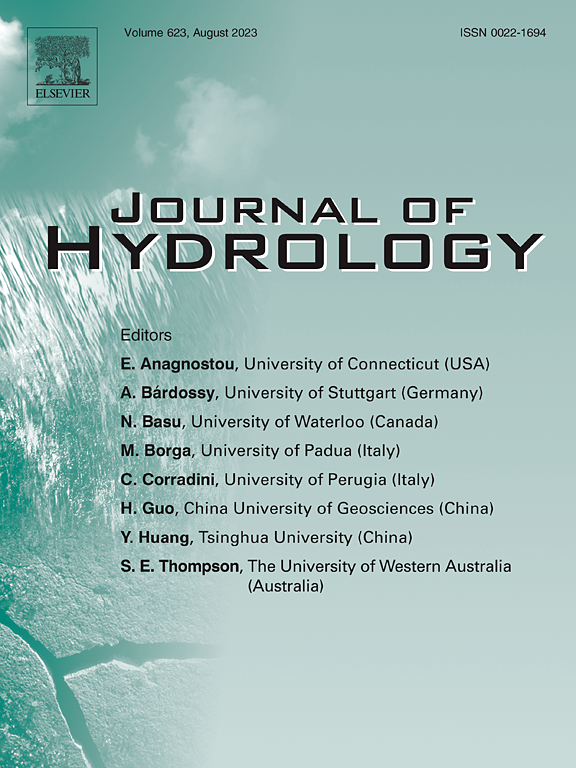模拟冻融循环引起的土壤硝酸盐垂直迁移
IF 6.3
1区 地球科学
Q1 ENGINEERING, CIVIL
引用次数: 0
摘要
土壤硝酸盐(NO3-N)是地下水污染的主要来源,对环境健康构成重大风险。研究了未来气候变化条件下,冻融循环在深层土壤热液动力学和0-2 m土壤剖面NO3-N垂直迁移中的关键作用。结果表明,与配备基于物理的冻融循环模块的SWAT- ft相比,SWAT- ft预测冬季地表土壤温度较低,深层土壤温度波动较小。由于原SWAT模型没有考虑水与冰的相变,因此模拟的冬季土壤含水量高于SWAT- ft模型。NO3-N损失在5月最大,超过30.9 kg ha - 1,但仅限于表层土壤。在11月、3月和4月,受遗留氮和入渗的影响,土壤损失向深层扩展。冻融期结束后,4月NO3-N损失达到峰值100 cm (7.0 kg ha - 1), SWAT-FT高排放情景下NO3-N损失进一步迁移至200 cm。至于土壤剖面下的硝态氮损失,4月份占全年总损失的近50%,突出了这个减少损失的关键月份。这些发现揭示了氮肥施用后瞬时风险和土壤遗留氮长期风险造成的NO3-N损失的“双重风险”,强调了在高风险时期考虑冻融循环影响和设计有针对性的氮肥管理的必要性。本文章由计算机程序翻译,如有差异,请以英文原文为准。

Simulating vertical soil nitrate migration induced by freeze–thaw cycles
Soil nitrate (NO3-N) is a major contributor to groundwater contamination, posing significant risks to environmental health. This study investigated the critical role of freeze–thaw cycles in driving deeper soil hydrothermal dynamics and NO3-N vertical migration within the 0–2 m soil profile under future climate change. Results showed that Soil and Water Assessment Tool (SWAT) predicted lower winter surface soil temperatures and less fluctuations in deeper soil layers than SWAT-FT, which equipped a physically-based freeze–thaw cycles module. Since the original SWAT model did not consider the phase transition of water and ice, the simulated soil water content was higher in winter than SWAT-FT. NO3-N losses were greatest in May with more than 30.9 kg ha−1 but were confined to surface soils. Losses in November, March, and April extended to deeper soils as influenced by legacy N and infiltration. Additionally, risk would increase with more severe emission scenarios, after freeze–thaw period, NO3-N losses peaked at 100 cm in April of 7.0 kg ha−1 and further migrated to 200 cm under high emission scenario for SWAT-FT. As for NO3-N losses below soil profile, April comprised nearly 50% of the annual total, highlighting this critical month for mitigating losses. These findings revealed a “dual risk” of NO3-N losses caused by instantaneous risk after fertilizer application and long-term risk from soil legacy N, highlighted the need to consider effects of freeze–thaw cycles and design targeted nitrogen management during high-risk periods.
求助全文
通过发布文献求助,成功后即可免费获取论文全文。
去求助
来源期刊

Journal of Hydrology
地学-地球科学综合
CiteScore
11.00
自引率
12.50%
发文量
1309
审稿时长
7.5 months
期刊介绍:
The Journal of Hydrology publishes original research papers and comprehensive reviews in all the subfields of the hydrological sciences including water based management and policy issues that impact on economics and society. These comprise, but are not limited to the physical, chemical, biogeochemical, stochastic and systems aspects of surface and groundwater hydrology, hydrometeorology and hydrogeology. Relevant topics incorporating the insights and methodologies of disciplines such as climatology, water resource systems, hydraulics, agrohydrology, geomorphology, soil science, instrumentation and remote sensing, civil and environmental engineering are included. Social science perspectives on hydrological problems such as resource and ecological economics, environmental sociology, psychology and behavioural science, management and policy analysis are also invited. Multi-and interdisciplinary analyses of hydrological problems are within scope. The science published in the Journal of Hydrology is relevant to catchment scales rather than exclusively to a local scale or site.
 求助内容:
求助内容: 应助结果提醒方式:
应助结果提醒方式:


